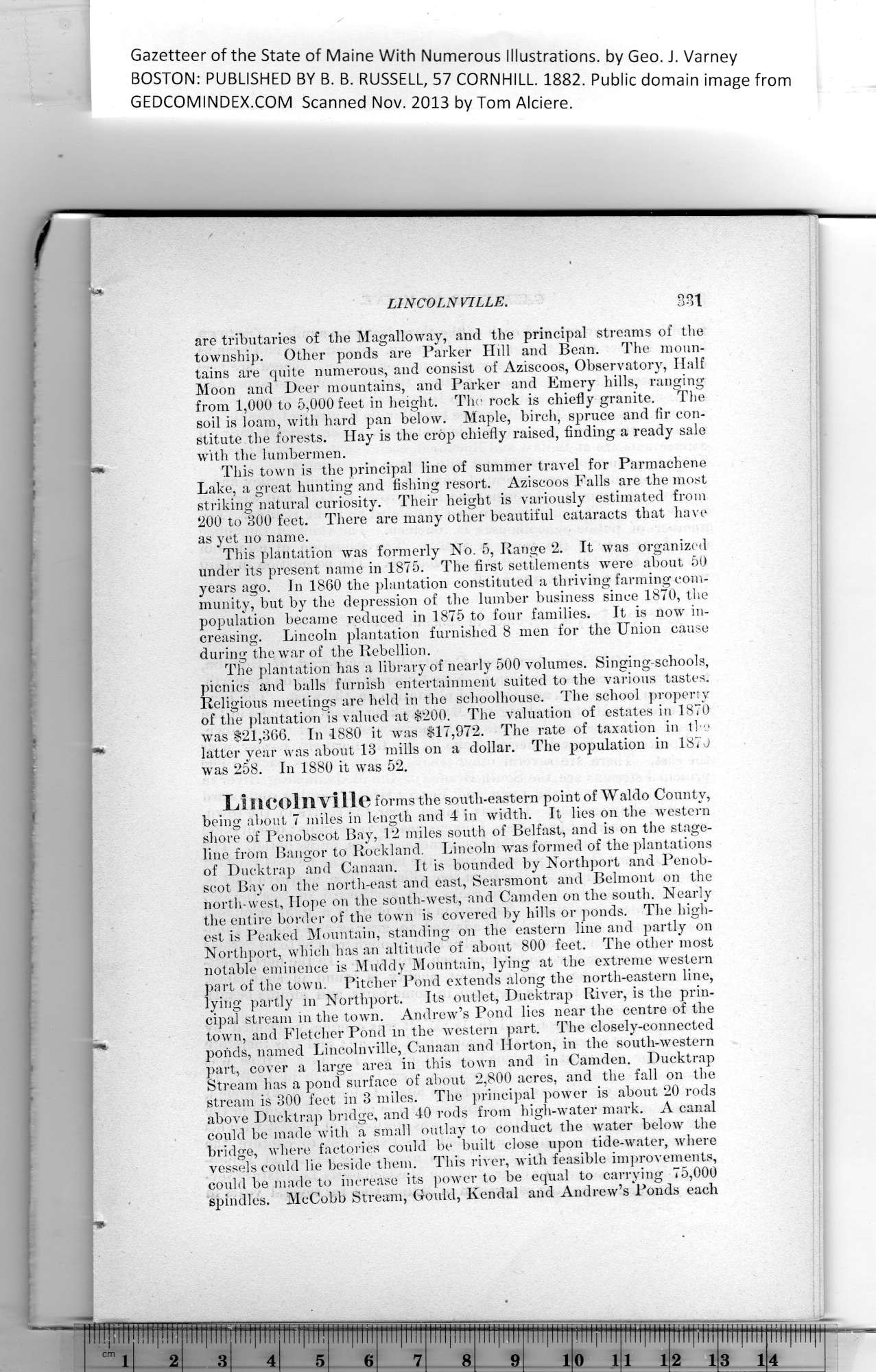|
Gazetteer of the State of Maine With Numerous Illustrations, by Geo. J. Varney
BOSTON: PUBLISHED BY B. B. RUSSELL, 57 CORNHILL. 1882. Public domain image from
LINCOLN VILIE. 381
are tributaries of the Magalloway, and the principal streams of the
township. Other ponds are Parker Hill and Bean. The moun-
tains are quite numerous, and consist of Aziscoos, Observatory, Half
Moon and Deer mountains, and Parker and Emery hills, ranging
from 1,000 to 5,000 feet in height. The rock is chiefly granite. The
soil is loam, with hard pan below. Maple, birch, spruce and fir con-
stitute the forests. Hay is the crop chiefly raised, finding a ready sale
with the lumbermen.
This town is the principal line of summer travel for Parmachene
Lake, a great hunting and fishing resort. Aziscoos Falls are the most
striking natural curiosity. Their height is variously estimated from
200 to 300 feet. There are many other beautiful cataracts that have
as yet uo name.
This plantation was formerly No. 5, Range 2. It was organized
under its present name in 1875. The first settlements were about 50
years ago. In 1860 the plantation constituted a thriving farming com-
munity, but by the depression of the lumber business since 1870, the
population became reduced in 1875 to four families. It is now in-
creasing. Lincoln plantation furnished 8 men for the Union cause
during the war of the Rebellion.
The plantation has a library of nearly 500 volumes. Singing-schools,
picnics and balls furnish entertainment suited to the various tastes.
Religious meetings are held in the schoolhouse. The school property
of the plantation is valued at $200. The valuation of estates in 1870
was $21,366. In 1880 it was $17,972. The rate of taxation in the
latter year was about 13 mills on a dollar. The population in 187J
was 258. In 1880 it was 52.
Lincoln ville forms the south-eastern point of Waldo County,
being about 7 miles in length and 4 in width. It lies on the western
shore of Penobscot Bay, 12 miles south of Belfast, and is on the stage-
line from Bangor to Rockland. Lincoln was formed of the plantations
of Ducktrap and Canaan. It is bounded by Northport and Penob-
scot Bay on the north-east and east, Searsmont and Belmont on the
north-west, Hope on the south-west, and Camden on the south. Nearly
the entire border of the town is covered hy hills or ponds. The high-
est is Peaked Mountain, standing on the eastern line and partly on
Northport, which has an altitude of about 800 feet. The other most
notable eminence is Muddy Mountain, lying at the extreme western
part of the town. Pitcher Pond extends along the north-eastern line,
lying partly in Northport. Its outlet, Ducktrap River, is the prin-
cipal stream in the town. Andrew’s Pond lies near the centre of the
town, and Fletcher Pond in the western part. The closely-connected
ponds, named Lincolnville, Canaan and Horton, in the south-western
part, cover a large area in this town and in Camden. Ducktrap
Stream has a pond surface of about 2,800 acres, and the fall on the
stream is 300 feet in 3 miles. The principal power is about 20 rods
above Ducktrap bridge, and 40 rods from high-water mark. A canal
could be made with a small outlay to conduct the water below the
bridge, where factories could be built close upon tide-water, where
vessels could lie beside them. This river, with feasible improvements,
could be made to increase its power to be equal to carrying 75,000
spindles. McCobb Stream, Gould, Kendal and Andrew’s Ponds each
PREVIOUS PAGE ... NEXT PAGE
This page was written in HTML using a program written in Python 3.2
|
